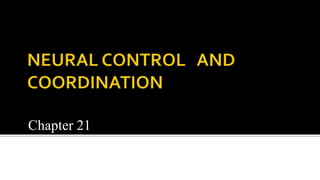
Neural Control And Coordination
- 1. Chapter 21
- 2. Our paired eyes are located in sockets of the skull called orbits The wall of the eye ball is composed of three layers : 1. The external layer is composed of a dense connective tissue and is called the sclera. 2. The anterior portion of this layer is called the cornea. 3. The middle layer, choroid, contains many blood vessels and looks bluish in colour.
- 3. The choroid layer is thin over the posterior two- thirds of the eye ball, but it becomes thick in the anterior part to form the ciliary body. The ciliary body itself continues forward to form a pigmented and opaque structure called the iris which is the visible coloured portion of the eye.
- 4. The eye ball contains a transparent crystalline lens which is held in place by ligaments attached to the ciliary body. In front of the lens, the aperture surrounded by the iris is called the pupil.The diameter of the pupil is regulated by the muscle fibres of iris
- 6. The inner layer is the retina and it contains three layers of cells – from inside to outside – ganglion cells, bipolar cells and photoreceptor cells. There are two types of photoreceptor cells, namely, rods and cones.These cells contain the light-sensitive proteins called the photopigments.The daylight (photopic) vision and colour vision are functions of cones and the twilight (scotopic) vision is the function of the rods.
- 7. The rods contain a purplish-red protein called the rhodopsin or visual purple, which contains a derivative ofVitamin A. In the human eye, there are three types of cones which possess their own characteristic photopigments that respond to red, green and blue lights. The sensations of different colours are produced by various combinations of these cones and their photopigments.When these cones are stimulated equally, a sensation of white light is produced.
- 8. The optic nerves leave the eye and the retinal blood vessels enter it at a point medial to and slightly above the posterior pole of the eye ball. Photoreceptor cells are not present in that region and hence it is called the blind spot. At the posterior pole of the eye lateral to the blind spot, there is a yellowish pigmented spot called macula lutea with a central pit called the fovea.The fovea is a thinned-out portion of the retina where only the cones are densely packed. It is the point where the visual acuity (resolution) is the greatest.
- 9. The space between the cornea and the lens is called the aqueous chamber and contains a thin watery fluid called aqueous humor.The space between the lens and the retina is called the vitreous chamber and is filled with a transparent gel called vitreous humor.
- 11. The light rays in visible wavelength focussed on the retina through the cornea and lens generate potentials (impulses) in rods and cones. The photosensitive compounds (photopigments) in the human eyes is composed of opsin (a protein) and retinal (an aldehyde of vitamin A). Light induces dissociation of the retinal from opsin resulting in changes in the structure of the opsin.This causes membrane permeability changes.
- 12. As a result, potential differences are generated in the photoreceptor cells.This produces a signal that generates action potentials in the ganglion cells through the bipolar cells.These action potentials (impulses) are transmitted by the optic nerves to the visual cortex area of the brain, where the neural impulses are analysed and the image formed on the retina is recognised based on earlier memory and experience.
Editor's Notes
- Page No. 323